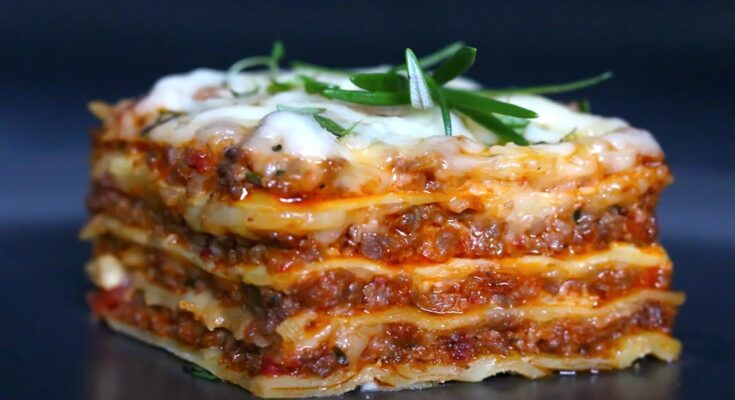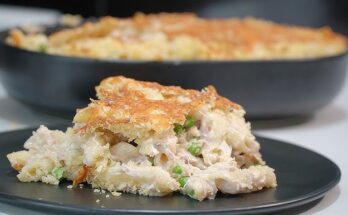Traditional Lasagna Recipe: Lasagna isn’t just food—it’s comfort on a plate. From Sunday dinners to festive holiday meals, lasagna has a special place in the hearts (and stomachs) of many. Its rich layers of pasta, hearty meat sauce, creamy cheese blend, and melted golden top make it a showstopper. It’s a dish that brings people together, reminding us of home-cooked meals, family gatherings, and maybe even a little friendly debate over whose version is best.
But beyond nostalgia, the beauty of traditional lasagna lies in its versatility and heartiness. Whether you’re cooking for two or twenty, lasagna scales well and satisfies like few other meals can. The combination of savory meat, herbs, tomatoes, and gooey cheese is simply irresistible.
What Makes a Lasagna “Traditional”?
A traditional lasagna is all about layers—and not just physical ones. It’s layered with flavor, history, and love. Classic Italian-American lasagna starts with a meaty tomato sauce, often referred to as a ragù or Bolognese. This slow-simmered sauce builds deep flavor with a base of onion, garlic, ground beef (or sometimes pork), and tomatoes.
Then comes the cheese—usually a rich blend of ricotta, mozzarella, and Parmesan. Ricotta provides the creamy texture, mozzarella gives that satisfying stretch, and Parmesan adds a salty, nutty kick.
Finally, there are the pasta sheets. Traditional recipes use boiled lasagna noodles, though no-boil options can work too. The goal? Layers that hold together but also melt in your mouth.
Ingredients Needed
For the Meat Sauce
- 1 lb ground beef (or a mix of beef and pork)
- 1 small onion, finely chopped
- 3 cloves garlic, minced
- 1 can (28 oz) crushed tomatoes
- 2 tbsp tomato paste
- 1 tsp sugar
- 1 tsp salt
- ½ tsp black pepper
- 1 tsp dried basil
- ½ tsp dried oregano
- Olive oil for sautéing
For the Cheese Filling
- 15 oz ricotta cheese
- 1 large egg
- 1½ cups shredded mozzarella cheese
- ½ cup grated Parmesan cheese
- ¼ tsp salt
- ¼ tsp ground nutmeg (optional, for a flavor boost)
For Assembling the Lasagna
- 9-12 lasagna noodles (depending on pan size)
- 1 cup shredded mozzarella (for topping)
- 2 tbsp grated Parmesan (for topping)
- Fresh basil or parsley for garnish (optional)
Kitchen Tools You’ll Need
- Large skillet or sauté pan
- Saucepan (for noodles)
- Mixing bowls
- Wooden spoon or spatula
- 9×13 inch baking dish
- Aluminum foil
- Knife and cutting board
Preparing the Meat Sauce
Browning the Meat
Start with a hot skillet and a drizzle of olive oil. Toss in the chopped onions and cook until soft and translucent—about 4-5 minutes. Add the minced garlic and sauté for another 30 seconds until fragrant. Now, add the ground meat, breaking it apart with your spoon. Brown it thoroughly until there’s no pink left. This step builds the foundation of flavor, so don’t rush it.
Simmering with Tomato and Herbs
Once the meat is browned, stir in the tomato paste to deepen the sauce’s flavor. Next, add the crushed tomatoes, sugar, basil, oregano, salt, and pepper. Bring it all to a gentle simmer, reduce the heat, and let it bubble away for at least 20–30 minutes. Stir occasionally and taste as you go. The longer it simmers, the more those flavors meld together into something magical.
Preparing the Cheese Mixture
Blending Ricotta, Parmesan, and Mozzarella
In a mixing bowl, combine ricotta cheese, the egg, Parmesan, mozzarella, salt, and a pinch of nutmeg if you’re using it. Mix until it’s well blended. The egg helps bind the mixture so it holds its shape between layers. The Parmesan adds depth, and the mozzarella makes it oh-so-satisfying.
This mixture is what gives the lasagna that creamy, rich texture in every bite. You can also add some chopped parsley or basil for an herbal twist.
Tips for Perfect Texture
For an extra smooth filling, let the ricotta sit in a sieve for about 10 minutes to drain excess moisture. If your ricotta is too wet, your lasagna can get soggy. Some folks even mix in a little sour cream or cream cheese for added creaminess—totally optional, but worth trying.
Boiling and Prepping the Lasagna Noodles
Traditional lasagna calls for classic boiled noodles—none of that oven-ready stuff here. You want your layers to be sturdy but tender, and that means giving the noodles a proper boil before they meet the sauce and cheese. Start by bringing a large pot of salted water to a rolling boil. Salt is key here because it’s the only chance you get to season the pasta itself.
Add the lasagna noodles in batches so they don’t stick together. Stir gently for the first minute or two—this helps prevent them from fusing into one large pasta blob. Boil them for about 8 minutes or until al dente (firm to the bite). Keep in mind that the noodles will continue to cook in the oven, so you don’t want them too soft at this stage.
Once boiled, carefully drain the noodles and lay them out flat on a clean kitchen towel or parchment paper. You can lightly oil them to prevent sticking if needed. This step is a bit tedious, but trust me—it’s worth it. There’s nothing worse than trying to separate torn noodles during assembly.
Pro tip: If you’re not assembling the lasagna immediately, cover the noodles with a damp towel to keep them from drying out. Smooth, intact noodles make for beautiful layers and an evenly cooked lasagna.
Assembling the Lasagna Step-by-Step
Layering Meat Sauce, Noodles, and Cheese
Now comes the fun part: building your lasagna like a cheesy, meaty lasagna skyscraper. Grab your 9×13 baking dish and start with a thin layer of meat sauce. This keeps the noodles from sticking to the bottom and adds flavor right from the first bite.
Next, lay down your first layer of noodles—usually 3 noodles fit perfectly side by side. Spread a third of the ricotta cheese mixture over the noodles. It doesn’t have to be perfect—use the back of a spoon to spread it out gently.
Follow up with a generous layer of meat sauce. Then sprinkle a handful of shredded mozzarella on top. Repeat the process: noodles, ricotta, meat sauce, mozzarella. Aim for at least three full layers. The final layer should be noodles topped with sauce and then a full blanket of mozzarella and Parmesan to finish.
How Many Layers Is Ideal?
Three to four layers is the sweet spot. Too few, and your lasagna feels flat. Too many, and you risk it becoming unstable or undercooked in the middle. As long as you end with a sauce and cheese layer, you’re golden.
A well-layered lasagna is like a symphony—each part harmonizes with the next. Don’t be shy with the cheese or sauce, but also don’t overdo it to the point where it becomes a soup. Balance is key.
Baking the Lasagna
Best Oven Temperature and Timing
Preheat your oven to 375°F (190°C). Cover the lasagna tightly with aluminum foil to keep the moisture in and bake it in the center rack for 25–30 minutes. This gives the flavors time to blend and the cheese to melt without drying out the top.
After that, remove the foil and bake for an additional 15–20 minutes. This is when the magic happens—the top layer of cheese becomes bubbly, golden, and ever so slightly crispy. You want that beautiful cheese crust, so don’t skip this step.
If the top is browning too quickly, place a piece of foil loosely over it to protect it while finishing the bake.
How to Know When It’s Done
You’ll know it’s ready when the edges are bubbling and the top is nicely browned. You can also check the center with a knife—it should go through easily and come out hot. If you’re unsure, use a thermometer; an internal temp of 160°F (71°C) ensures it’s cooked all the way through.
Letting It Rest Before Serving
Why Resting Time Is Crucial
This part may be the hardest—waiting. But if you want clean slices that hold their shape and don’t slide all over the plate, let your lasagna rest for at least 15–20 minutes after baking. Tent it with foil and resist the urge to dig in immediately.
During this time, the cheese sets, the layers firm up, and the sauce thickens. Cutting into a hot, bubbling lasagna right out of the oven will only leave you with a messy puddle on your plate.
So pour yourself a glass of wine, set the table, and let the lasagna chill out a bit. Trust me, it’s worth the wait.
Serving Suggestions
What Goes Best with Traditional Lasagna?
Lasagna is a rich, hearty meal on its own, but pairing it with the right sides takes it to the next level. Think of it like a concert—you’ve got the main act (lasagna), but the opening acts (your side dishes) set the mood just right.
A crisp green salad is always a win. Go with something light and zesty—like arugula with lemon vinaigrette or a simple Caesar with crunchy croutons. The acidity and freshness balance out the richness of the cheese and meat.
Don’t forget the bread. Garlic bread or a warm, crusty Italian loaf is practically mandatory. You’ll need it to mop up all that saucy, cheesy goodness left on the plate.
Want to go a little extra? Serve it with roasted vegetables—zucchini, carrots, bell peppers, or asparagus tossed in olive oil and herbs. They bring a colorful, nutritious twist to the meal without overshadowing the star of the show.
And of course, a glass of red wine—Chianti, Merlot, or even a Pinot Noir—will complement those deep, meaty flavors beautifully. If wine’s not your thing, a sparkling water with a splash of lemon does the trick just fine.
Tips to Elevate Your Lasagna
Common Mistakes to Avoid
Even seasoned home cooks can hit a few bumps when making lasagna. One common misstep? Over-saucing. While you want generous layers, too much sauce makes your lasagna soggy. Same goes for overcooking the noodles—remember, they continue to cook in the oven.
Another biggie? Skipping the rest period after baking. It might seem harmless, but cutting too soon can turn those gorgeous layers into a gooey mess.
Also, don’t use low-moisture ricotta or mozzarella straight from the fridge. Let your cheeses come to room temp before mixing or layering. This helps everything melt more evenly and smoothly.
And yes, seasoning matters! Every layer should have a little flavor—taste your sauce, season your cheese mix, and don’t be shy with the herbs.
Make-Ahead and Storage Tips
Lasagna is actually even better the next day. Make it ahead of time, cover tightly with foil, and refrigerate overnight. This gives the flavors even more time to mingle.
You can also freeze it—either before or after baking. If freezing before, assemble it in a freezer-safe dish and skip the final cheese topping until baking. Wrap it tightly and freeze for up to 2 months. When ready to cook, thaw overnight in the fridge and bake as directed.
If you’ve got leftovers (lucky you!), store slices in airtight containers in the fridge for up to 4 days. Reheat in the oven or microwave—just cover with a damp paper towel to keep it from drying out.
FAQs about Traditional Lasagna Recipe
What are the key ingredients in a traditional lasagna recipe?
A classic lasagna generally includes layers of pasta sheets, ricotta cheese, mozzarella cheese, Parmesan cheese, a hearty meat sauce (typically made with ground beef, pork, or a combination), and a rich tomato sauce. Fresh herbs like basil and oregano also add a burst of flavor.
How long does it take to make traditional lasagna?
Preparing a traditional lasagna can take about 2 to 3 hours, including the sauce simmering and baking time. For a smoother process, you can make the sauce ahead of time.
Can traditional lasagna be made vegetarian?
Absolutely! Swap the meat sauce for a rich, chunky marinara sauce packed with vegetables like zucchini, mushrooms, bell peppers, and spinach. Use plant-based cheeses to make it vegan.
What are some tips for layering a lasagna?
Start with a spoonful of sauce at the bottom of your baking dish to prevent sticking. Then, layer in this order: pasta sheets, ricotta cheese mixture, mozzarella cheese, meat sauce, and repeat. Finish with a layer of pasta, sauce, and a generous sprinkling of Parmesan cheese.
Is it necessary to cook the lasagna noodles before assembling?
It depends on the type of noodles you use. Traditional noodles need to be boiled until al dente before layering. However, no-boil lasagna noodles are a convenient alternative that can save you some time.
How can I prevent my lasagna from becoming too watery?
To avoid a watery lasagna, make sure your tomato sauce isn’t too thin, and let the cooked meat sauce reduce to remove excess liquid. Also, if using vegetables, sauté them first to remove moisture.
What’s the best way to serve lasagna?
Allow the lasagna to rest for about 15 minutes after baking. This resting period helps the layers settle and makes it easier to cut into neat squares. Serve warm with a side of garlic bread or a crisp salad.
Conclusion
There you have it—the ultimate guide to making a traditional lasagna that’s comforting, delicious, and perfect for just about any occasion. Whether you’re feeding a crowd or just want to indulge in some homemade goodness, lasagna never disappoints.
From the slow-simmered meat sauce to the rich, creamy cheese layers and that golden, bubbly top, every bite delivers comfort and satisfaction. Stick to the classics, respect the layering process, and most of all—make it with love.
And hey, once you’ve nailed the traditional version, don’t be afraid to experiment! Add some spinach, swap in different cheeses, or go meatless for a veggie twist. Lasagna is more than a meal—it’s a canvas. Now go impress your guests (or just yourself) with a dish that’ll have everyone coming back for seconds.



